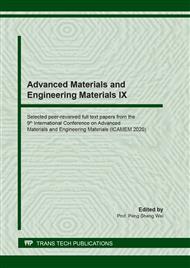[1]
Mohri, N. and T. Tani, Recent evolution of electrical discharge machining, in 4M 2006-Second International Conference on Multi-Material Micro Manufacture. 2006, Elsevier.
DOI: 10.1016/b978-008045263-0/50006-4
Google Scholar
[2]
Hoang, T.T., et al., Modelling Surface Finish in Electrical Discharge Machining Tablet Shape Punches using Response Surface Methodology. International Journal of Mechanical Engineering and Robotics Research. 4(9): pp.28-30.
DOI: 10.14445/23488360/ijme-v4i9p106
Google Scholar
[3]
Le Xuan Hung, T.T.H. and V.N. Pi, A Study on Modelling Surface Finish in Electrical Discharge Machining Tablet Shape Punches Using Response Surface Methodology. Journal of Environmental Science and Engineering B 6 (2017) 387-390.
DOI: 10.17265/2162-5263/2017.07.006
Google Scholar
[4]
Ho, K. and S. Newman, State of the art electrical discharge machining (EDM), International Journal of Machine Tools and Manufacture. 43(13) (2003) 1287-1300.
DOI: 10.1016/s0890-6955(03)00162-7
Google Scholar
[5]
Luis, C., I. Puertas, and Villa, Material removal rate and electrode wear study on the EDM of silicon carbide, Journal of materials processing technology. 164 (2005) 889-896.
DOI: 10.1016/j.jmatprotec.2005.02.045
Google Scholar
[6]
Marafona, J. and C. Wykes, A new method of optimising material removal rate using EDM with copper–tungsten electrodes, International Journal of Machine Tools and Manufacture. 40(2) (2000) 153-164.
DOI: 10.1016/s0890-6955(99)00062-0
Google Scholar
[7]
Salonitis, K., et al., Thermal modeling of the material removal rate and surface roughness for die-sinking EDM, The International Journal of Advanced Manufacturing Technology. 40(3-4) (2009) 316-323.
DOI: 10.1007/s00170-007-1327-y
Google Scholar
[8]
Jabbaripour, B., et al., Investigating the effects of EDM parameters on surface integrity, MRR and TWR in machining of Ti–6Al–4V, Machining Science and Technology. 16(3) (2012) 419-444.
DOI: 10.1080/10910344.2012.698971
Google Scholar
[9]
Zarepour, H., et al., Statistical analysis on electrode wear in EDM of tool steel DIN 1.2714 used in forging dies, Journal of Materials Processing Technology. 187 (2007) 711-714.
DOI: 10.1016/j.jmatprotec.2006.11.202
Google Scholar
[10]
Shunmugam, M., P. Philip, and A. Gangadhar, Improvement of wear resistance by EDM with tungsten carbide P/M electrode, Wear. 171(1-2) (1994) 1-5.
DOI: 10.1016/0043-1648(94)90340-9
Google Scholar
[11]
Bleys, P., et al., Real-time tool wear compensation in milling EDM, CIRP Annals. 51(1) (2002) 157-160.
DOI: 10.1016/s0007-8506(07)61489-9
Google Scholar
[12]
Marafona, J., Black layer characterisation and electrode wear ratio in electrical discharge machining (EDM), Journal of Materials Processing Technology. 184(1-3) (2007) 27-31.
DOI: 10.1016/j.jmatprotec.2006.10.045
Google Scholar
[13]
Huo, J., et al., Influence of process factors on surface measures on electrical discharge machined stainless steel using TOPSIS, Materials Research Express. 6(8) (2019).
DOI: 10.1088/2053-1591/ab1ae0
Google Scholar
[14]
Bleys, P., et al., Surface and sub‐surface quality of steel after EDM, Advanced Engineering Materials. 8(1‐2) (2006) 15-25.
Google Scholar
[15]
Jabbaripour, B., et al., Investigating surface roughness, material removal rate and corrosion resistance in PMEDM of γ-TiAl intermetallic, Journal of Manufacturing Processes. 15(1) (2013) 56-68.
DOI: 10.1016/j.jmapro.2012.09.016
Google Scholar
[16]
Tripathy, S. and D. Tripathy, An approach for increasing the micro-hardness in electrical discharge machining by adding conductive powder to the dielectric, Materials Today: Proceedings. 4(2) (2017) 1215-1224.
DOI: 10.1016/j.matpr.2017.01.140
Google Scholar
[17]
Kung, K.-Y., J.-T. Horng, and K.-T. Chiang, Material removal rate and electrode wear ratio study on the powder mixed electrical discharge machining of cobalt-bonded tungsten carbide, The International Journal of Advanced Manufacturing Technology. 40(1-2) (2009) 95-104.
DOI: 10.1007/s00170-007-1307-2
Google Scholar
[18]
Ranjit, K.R., A Primer on the Taguchi method, Society of Manufacturing Engineers, Dearborn, Michigan, USA, (2010).
Google Scholar


